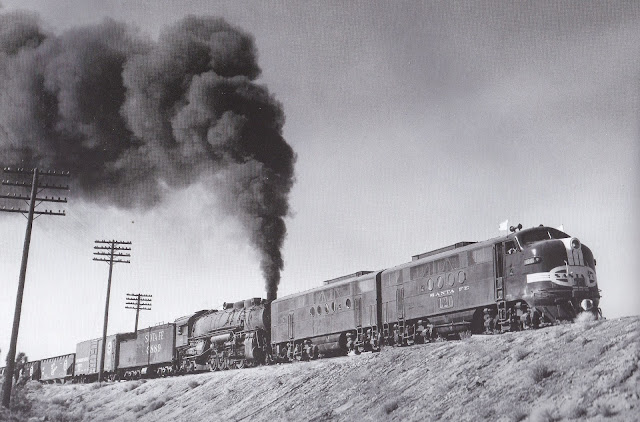Our Victorville locomotives this time are Santa Fe's all-blue EMD freight FT diesels of 1951-52. Then we'll look at my slow layout progress again, as I rewired things to try to test my walkaround control scheme.
One of several paint schemes that the Santa Fe tried on their freight FT diesels in the postwar years was the experimental "all-blue" scheme that was applied to about two dozen FT sets during 1951 and 1952, but they were repainted during 1953. Some of these sets had all four ABBA units, but some had three, two, or just one unit. The sets were used as both road engines and as helpers during this time.
Here we see FT set #170 as a helper at Summit in May of 1951, as shot by Chard Walker:
Note that the only yellow paint is in the vertical nose stripe and the "cigar band" emblem on the nose. This was Santa Fe's first use of the cigar band on freight units, in place of the previous "cat whiskers" scheme.
Here's a super shot by Stan Kistler, showing FT set #120 helping 2-10-2 #3889 west out of Victorville, climbing near Frost in June, 1952:
There are not many shots of these units on Cajon Pass, so I'm including this shot of #194 westbound with a freight in Corona (west of San Bernardino) by Ed Von Nordeck:
Here we see set #120 eastbound with a freight in San Bernardino, thanks to Jack Whitmeyer:
Here we see three-unit set #151 with a westbound freight at Summit (on the right), while a two-unit FT set in the previous paint scheme (yellow along the upper sides and cat whiskers on the nose) pushes backwards on the rear of an eastbound freight in June of 1952, thanks again to Stan Kistler:
Returning to Corona for our final photo, here is set #170 with a westbound freight in 1951, thanks again to Ed Von Nordeck:
I only know of one HO model of these all-blue units, produced by Stewart many years ago. I have an ABBA set of these (although I can't locate them among my treasures at the moment). Here's a catalog photo of two Stewart units:
Now let's look at my slow layout progress. I decided that I should test my proposed walkaround control system before going much further. I tested it years ago on a test track, but I need to know that the radio signals will work across the entire basement.
I parked the Blue Goose in the E Yard in the staging room and put my old Athearn F7 back on the track for the tests. I disconnected the bus wires that were running across the top of the layout and rerouted them under the layout, where they belong, then reconnected them to the terminal strip.
I placed a TV tray beside the layout (near the double-slip switches) and placed three control boxes in a row on the tray: an MRC Tech 7 power pack on the left, then a Crest (formerly AristoCraft) radio receiver box in the middle, and then a Kato Sound Box on the right, as seen here:
I figured out how to wire them in series, with the the DC power going from the power pack into the Crest radio receiver, and from there into the Sound Box, and from there to the terminal strip, and from there to the various track blocks on the outer mainline.
Also, the blue box on the left side of the Sound Box gets AC power from the power pack, to power the sounds when a Kato Sound Card is in the slot on top (I'm using a 1st-generation EMD sound card to match the F7).
The next step was put new batteries into the Crest walkaround controller (standing up on the tray against the benchwork). Then I worked through all the convoluted steps in getting the walkaround controller set to a chosen radio frequency and synced to the receiver on the same frequency.
For your entertainment, here are the first steps in setting the frequency (the page on the right):
This process continues on the left page here:
I think the transmitter and receiver got linked correctly, judging from the lights that blinked during the process.










No comments:
Post a Comment